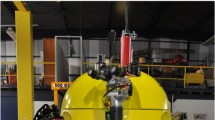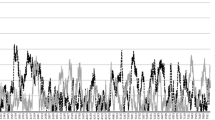Abstract
In this paper, we propose a method for real-time horizon tracking (i.e., separation line between the sky and the sea) in a maritime operations context. We present the fusion of an image processing algorithm with the data obtained from the inertial measurement unit (IMU). The initial aim is to filter out environmental conditions using inertial information in order to combine a video stream with onboard electronic charts. This is achieved by the detection of the horizon with an image processing algorithm in an area defined by the IMU. We then present an evaluation of the algorithm with regard to the rate of detection of the horizon and the impact of the image resolution on the computational time. The purpose of developing this method is to create an augmented reality maritime operations application. We combine the video stream with electronic charts in a single display. We use the position of the horizon in the image to split the display into different areas. Then, we use transparency to display the video, the electronic charts or both.














Similar content being viewed by others
Notes
Electronic chart display and information system.
Automatic identification system: automated tracking system for identifying and locating vessels.
Automatic radar plotting aid: radar feature for tracking others vessels with echo radar.
Considering the dimensions, we assume that the vessel’s center of rotation is anchored in (VRP).
Intel Open Source Computer Vision.
Instructions directly executed by the graphic card.
References
Bouma H, de Lange DJJ, van den Broek PS (2008) Automatic detection of small surface targets with electro-optical sensor in a harbor environment. In: Proceedings of SPIE electronic imaging 2008 system analysis for digital photography, vol. 7114, pp 1–8
Calvary G, Coutaz J, Thevenin D, Limbourg Q, Bouillon L, V J (2003) A unifying reference framework for multi-target user interfaces. Interact Comput 15:289–308
Cornall T (2004) A low computation method to determine horizon angle from video-preliminary version. Technical Report MECSE-4-2004
Ettinger S, Nechyba M, Ifju P, Waszak M (2002) Vision-guided flight stability and control for micro air vehicles. In: Intelligent robots and systems, 2002. IEEE/RSJ international conference on, vol. 3, pp 2134–2140
Fefilatyev S, Smarodzinava V, Hall LO, Goldgof DB (2006) Horizon detection using machine learning techniques. In: Machine learning and applications, 2006. ICMLA ’06. 5th international conference on, pp 17 –21
French Government: Oceans round table (grenelle de la mer) (2009). http://www.legrenelle-environnement.fr/IMG/pdf/Livre_bleu_anglais_web.pdf
Grant S, Goodyear J (2010) ECDIS: past, present and future. Online : http://www.mar.dfo-mpo.gc.ca
Hugues O, Cieutat JM, Guitton P (2010a) An experimental augmented reality platform application for assisted maritime navigation: following targets. In: 12th virtual reality international conference (VRIC), ISBN: 2-9515730-9-X, pp 149–154. IEEE Computer Society France
Hugues O, Cieutat JM, Guitton P (2010b) An experimental augmented reality platform for assisted maritime navigation. In: AH ’10 proceedings of the 1st augmented human international conference, pp 1–6. ACM, New York, NY, USA
Jie W, Xian-Zhong H (2008) The error chain in using electronic chart display and information systems. In: Systems, man and cybernetics, 2008. SMC 2008. IEEE international conference on, pp 1895–1899
Maidi M (2007) Hybrid tracking with occultation for augmented reality. (suivi hybride en présence d’occultations pour la réalité augmentée). Ph.D. thesis, Evry-Val d’Essone University, Évry
MTI XSens: Mti (2013) http://www.xsens.com/en/general/mti
International Maritime Organization (IMO): Resolution MSC.192(79)) (2007) Proposed modular structure for RADAR performance standards. Design and installation. CCRP and off-set compensation
Petit M, Claramunt C, Ray C, Calvary G (2008) A design process for the development of an interactive and adaptive GIS. In: Bertolotto M, Li X, Ray C (eds) Proceedings of the 8th international symposium on web and wireless geographical information systems, vol. 5373, pp 100–111. Springer
Phillips OM (1966) The dynamics of the upper ocean. Cambridge monographs on mechnics and applied mathematics. Cambridge University Press, Cambridge
Pillich B, Buttgenbach G (2001) Ecdis-the intelligent heart of the hazard and collision avoidance system. In: Intelligent transportation systems, 2001. Proceedings. 2001 IEEE, pp 1116–1119
Ribo M, Lang P, Ganster H, Brandner M, Stock C, Pinz A (2002) Hybrid tracking for outdoor augmented reality applications. IEEE Comput Graph Appl 22(6):54–63
Todorovic S, Nechyba MC (2004) A vision system for horizon tracking and object recognition for micro air vehicles. In: Florida conference on recent advances in robotics
Wang Y, Liao Z, Guo H, Liu T, Yang Y (2009) An approach for horizon extraction in ocean observation. In: Image and signal processing, 2009. CISP ’09. 2nd international congress on, pp 1 –5
Woo JH, Kim GS (2005) Robust horizon and peak extraction for vision-based navigation. Conference on machine vision application (MVA2005) pp 526–529
You S, Neumann U (2001) Fusion of vision and gyro tracking for robust augmented reality registration. IEEE virtual reality conference pp 71–78
You S, Neumann U, Azuma R (1999) Hybrid inertial and vision tracking for augmented reality registration. In: VR ’99: Proceedings of the IEEE virtual reality, p 260. IEEE Computer Society, Washington, DC, USA
Yuan HZ, Zhang XQ, Feng ZL (2010) Horizon detection in foggy aerial image. In: Image analysis and signal processing (IASP), 2010 international conference on, pp 191–194
Zabala FA (2006) Hough transform implementation in roll stability control of uavs. E-Book
Zafarifar B, Weda H, de With PHN (2008) Horizon detection based on sky-color and edge features. Visual Commun Image Process 2008 6822(1):682220
Author information
Authors and Affiliations
Corresponding author
Rights and permissions
About this article
Cite this article
Hugues, O., Cieutat, JM. & Guitton, P. Real-time infinite horizon tracking with data fusion for augmented reality in a maritime operations context. Virtual Reality 18, 129–138 (2014). https://doi.org/10.1007/s10055-013-0234-9
Received:
Accepted:
Published:
Issue Date:
DOI: https://doi.org/10.1007/s10055-013-0234-9




